Chalmers Automobile
Chalmers Motor Company was an American automobile company headquartered in Detroit, Michigan. It started in 1908 and continued production of high end vehicles until 1923 when it merged with Chrysler.
| Industry | Automobile |
|---|---|
| Fate | Merged with Maxwell automobile |
| Founded | 1908 |
| Founder | Hugh Chalmers |
| Defunct | 1923 |
| Headquarters | , USA |
| Products |
|
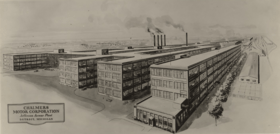
History
Origin
In 1899 E.R. Thomas funded a car called the AutoTwo,.[1] In 1902, the E.R. Thomas Motor Company (later called Thomas-Detroit) was created.[1]
Hugh Chalmers
Hugh Chalmers started working at NCR in Dayton, Ohio at age 14 and worked himself from an office boy while going to night school, eventually working his way up to become Vice President and General Manager.[2] He was known nation-wide for his salesmanship and merchandising abilities.[2] In 1907 car-maker Roy Chapin at Thomas-Detroit began to make offers to Hugh Chalmers come to Detroit and join the company as Thomas-Detroit was in its second year already car sales were sliding.[2] Initially Hugh Chalmers rejected the offers but he finally accepted when Hugh Chalmers was to be President with "Chalmers" incorporated into the company name.[2] In 1908, Hugh Chalmers took over as President of Thomas-Detroit and the name was changed to Chalmers-Detroit by mid-1908.[2] Hugh Chalmers, purchased the interests of ER Thomas in the Thomas-Detroit company in 1908.[1] The first car that came out was the Chalmers 30 in 1908.[3] The company acquired the Brush Runabout rights.[3]
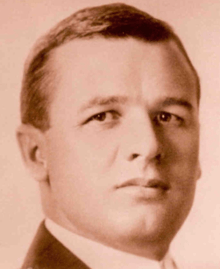
Hugh Chalmers set up Joseph E. Fields as a distributor in Fargo.[1] Fields moved to Detroit and began to set up dealerships across the US.[1] In 1907 or 1909 Chalmers built a plant on Jefferson Avenue in Detroit which would survive until 1991 under Chrysler.[1] Chalmers' headquarters was in Highland Park, Michigan.[1][1][1][1] [./Chalmers_Automobile#cite_note-Zatz-1 [1]]
Chalmers vastly increased the company's visibility by hiring professional drivers and entering many road races, hill climbing events, and reliability contests.[2] In the first two years of competition, they won 89 first place wins, 32 second-place trophies, and 21 third place victories.[2] The most prestigious wins being the Vanderbilt Cup in 1909 and the Glidden Trophy in 1910.[2]
Investor and designer Roy D. Chapin had a difference of opinion and wanted to build a smaller model.[1] On October 28th, 1908 Chapin, Coffin and others formed the Hudson Motor Car company named after department store owner Joseph Hudson.[3] Hugh Chalmers was also a large investor in Hudson.[3]
In 1909–10, Hugh Chalmers and his partners sold their interests in Hudson to Chapin and Chapin sold his interest in Chalmers Motors to Hugh Chalmers.[1] Hudson built their plant across the street from the Chalmers plant to be close to suppliers and the railroad.[1]
Peak
Chalmer's best year was 1911 when it became the number eight auto producer in the US.[3] In 1916, Chalmers set up a Canadian branch factory in Walkerville (Windsor), Ontario.[1]
Hugh Chalmers was not an engineer but was known as a "super salesman" as Vice President & General Manager of NCR.[4]
Chalmers Motors early success was largely due to Roy Chapin and Howard Coffin who both had previous experience in the auto industry.[4] Chapin was the Treasurer & General Manager and Coffin served as the Chief Engineer and was experienced in automobile design and engineering.[4] In 1909, Chapin and Coffin left Chalmers-Detroit to start the Hudson Motor Car Company and Hugh Chalmers increasingly focused on building larger, more luxurious cars.[4] He incorrectly speculated that the decreased car sales were the result of production inefficiencies.[4]
At first, engines were manufactured by three outside suppliers but later engine manufacturing was brought in house.[2] An advantage of the new Chalmers plant was its self-sufficiency.[2] Raw pig iron was shipped in and processed by the on-site foundry and machine shop to make engines, transmissions, and axles and even the nuts, bolts, and screw fasteners.[2] Chalmers wanted to make as many parts in house and only bought specialized parts like sparkplugs & tires from outside suppliers.[2] The high point in sales was in 1911 when Chalmers sold 6,250 cars.[2] Chalmers shareholders also did well.[2] Preferred stock dividends paid out 7% per year and the common stock paid 2.5% annually.[2]
Beginning in 1912, Chalmers began to slowly lose sales momentum.[2] The problem faced a combination of low-volume, high-cost, and excess manufacturing capacity.[2]
Hugh Chalmers created Saxon Motors in 1913.
By 1915 the auto-business was changing and what was once a hobby-like young industry of entrepreneurs and inventors was now very competitive.[4] The Chalmer's survival was constantly at risk with over 250 automakers in the U.S.[4]
Pre-World War I the automobile economy was booming but sales of Chalmers' cars were declining and Hugh Chalmers attempted to improve his manufacturing process to try to reverse this trend.[4]
A new model was introduced in mid-1916 with impressive engine performance and an improved body design, and its sales boosted Chalmers' production ranking from 14th to 12th place among automakers.[4] Car sales were still not good enough and by late 1916 the company was close to bankruptcy.[4]
Maxwell Motors
The Maxwell Motor Company started in 1904/5 by Benjamin & Frank Briscoe and Jonathan Maxwell.[4]
Hugh Chalmers reorganized the company in September 1917 into the "Chalmers Motor Corporation" and leased all the factory space to the Maxwell Motor Company for 5-years.[4]
Maxwell was to also to produce the Chalmers car and Walter E. Flanders, president of the Maxwell Motor Company, became president of Chalmers.[4] Hugh Chalmers was promoted up to become Chairman of the Board of Directors for the new Chalmers Motor Corporation.[4]
Hugh Chalmer left for Washington, D.C. to serve on the National Automobile Chamber of Commerce (NACC) as one of the "dollar a-year-men" as they were paid one dollar-a-year for their services.[4] The NACC's purpose was to organize the mobilization and production of war material manufactured in Detroit's auto plants.[4]
During 1917, following the April United States Declaration of War against Germany, Maxwell Motor Co took over Chalmers' operations to make cars and trucks for the US Government.[5] Chalmers merged with the Maxwell Automobile Company, in 1922.[6] With a 115 in (2921 mm) wheelbase on 34 in (86 cm) wheels,[7]:107
When the US entered World War I demand weakened for the Chalmers while the Maxwell cars were outselling the Chalmers.[1] In 1917, the companies came to an agreement that Maxwell cars would be built in the Chalmers plant on Jefferson Avenue, and Maxwell dealers would sell Chalmers cars.[1] This worked well for a while.[1]
Demise
Between 1919 and 1923, Chalmers suffered financial problems and merged with the Maxwell Motor Company.[8] In late November 1921, prices were reduced for all models and production was down to about 20 cars a day while Maxwell was selling more than 100 cars a day.[8] Later they were taken over by Walter P. Chrysler. [9]
When Hugh Chalmers returned to Detroit in 1919 both companies now had financial problems and in mid-1920, the bank creditors ordered a reorganization committee to find a resolution.[4]
Chase National Bank at that time had recruited the help of Walter P. Chrysler to rescue of Willys Overland Company and they asked Chrysler to also head the reorganization committee in the Chalmers-Maxwell reorganization.[4] The relationship between Chalmers and Maxwell had become nasty and included lawsuits and counter-lawsuits amounting to several millions of dollars.[4] The Chalmers-Maxwell reorganization committee found that the lease agreement too loose and poorly constructed.[4]
[1] In 1920, a combination of a post-war recession material shortages and rising prices hurt both Maxwell and Chalmers.[1] In 1921, Maxwell stopped production in the Chalmers plant.[1] In 1922, Maxwell Motor Corporation bought Chalmers Motor Corporation for $2 million.[1] Maxwell had financial problems and in 1923 hired Chrysler to sort matters.[1]
In 1923, Chrysler forced both Chalmers and Maxwell into bankruptcy to stop most of the lawsuits He bought back the assets of both companies from the bankruptcy court, and formed a new company, the Maxwell Motor Corporation.[4]
The Chalmers name was discontinued in January 1924, when production of the Chrysler Six started in the former Chalmers plant. [9]
In early 1924, the first Chrysler was produced from the old Chalmers plant but Maxwell continued production for another year.[4] Thirty-two thousand Chryslers were sold in 1924 making a sales record in the auto industry for a first-year startup.[4]
Model series
"Forty"
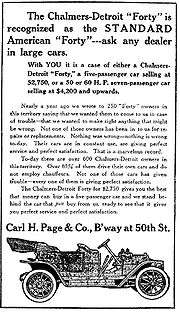
The first car by Chalmers-Detroit was the 1908 Model C "Forty" which is much like the 1907 Thomas-Detroit C "Forty" which was very similar to the car designed by Howard Coffin, the 1906 Olds Model "A".[10]
The "Forty" model series is made up of five models called C "Forty", D "Forty", E "Forty", J "Forty", and L "Forty". [10] The letter is the model and "Forty" is the trade name. [10] Each model progressively brought in higher horsepower, increased wheelbase and larger tire size. [10] Available bodies were Touring, Roadster, Speed Roadster, Pony Tonneau, Torpedo, Tourabout, Runabout, Limousine, Inside Drive Coupe, and Landaulet for some of the models. [10] Production of the "Forty" stopped in early 1913. [10]
All engines (other than the C model) have a L head, "over-square" design. [10] This engine had four cylinders cast in blocks of two cylinders each.[10] The engines were manufactured by Continental, American and British Manufacturing Company, and Westinghouse Machine Company until in 1911, when Chalmers started building most of its engines.[10] The "Forty" engine had a small radiator which led to overheating.[10] Both a foot brake which operates on the transmission and a hand brake which operates on the rear drums.[10]
Cost
The 40 Touring or Roadster sold for US$2750 while the 40 Torpedo sold for US$3000.[7]:107 While expensive this was less than American's lowest-price model which sold for US$4250.[7]:104
"30" and "36"
|
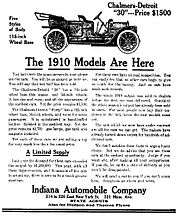
The "30" model series has the following models F "30", K "30", M "30", 9 "30", 10 "36", 11 "30", 14 "30", 16 "30"
and the "36" model series has the following models
17 "36" and 19 "36". [10]
Again, sort of consistent with the "Forty", the letter or number is the model and the term "30", or "36" is the trade name. [10] The "30" remained more or less the same but the "36" (introduced in 1912) had a longer stroke and higher horsepower 4 cylinder engine. [10]
Nickel plate started to replace the brass in cars during this time as it was easier to maintain and Gray & Davis electric headlights replaced the gas headlights. [10] The following body styles were available; Touring, Roadster, Torpedo, Limousine, Limousine (Cab Side), Limousine (Berlin), Tourabout, Runabout, Pony Tonneau, Inside Drive Coupe, Landaulet, Torpedo Roadster, Coupe. [10]
Chalmers produced only one truck type in its history and called it the Model 14 Delivery. [10]
The F-head engine had a crankshaft with 3 offsets and two sets of main (ball) bearings and the 2nd and 3rd piston connecting rods shared one long crankpin. [10] This resulted in a short, stiff crankshaft that gave more reliability. [10] The car has dual ignition with one set of spark plugs connected to coils (one for each spark plug) and the other set connected to a Bosch magneto.[10] All engines have overhead intake valves fed by a Mayer carburetor or later with a Rayfield carburetor. [10] The Model "36" has a 4-speed transmission. [10] The foot brake is combined with the clutch pedal so when pushed half way it releases the clutch. [10] The "30" also had a "ratchet sprang" which would hold the car on an uphill grade without having to hold the brakes.[10]
The company made several specific "30" racers and some famous versions are the Blue Birds at Crown Point, Indiana and Old Number Five in the Glidden tours. [10]
| Model | Production ears | Advertised HP | SAE HP | Cyl | Bore (in) | Stroke (in) | Tire Size (in) | Wheel Base (in) |
|---|---|---|---|---|---|---|---|---|
| F | 1908-19 | 30 | 24.03 | 4 | 3 ⅞ | 4 ½ | 32 X 3 | 110 |
| K | 1909-? | 30 | 25.6 | 4 | 4 | 4 ½ | 34 X 3½ | 110 |
| M | 1910-? | 30 | 25.6 | 4 | 4 | 4 ½ | 34 X 3½ | 115 |
| 9 | 1911-? | 30 | 25.6 | 4 | 4 | 4 ½ | 34 X 3½ | 104 |
| 10 | 1912-? | 30 | 25.6 | 4 | 4¼ | 5¼ | 36 X 4 | 115 |
| 11 | 1912-? | 30 | 25.6 | 4 | 4 | 4 ½ | 34 X 4 | 115 |
| 14 | 1912-? | 30 | 25.6 | 4 | 4 | 4 ½ | 34 X 5½ | 115 |
| 16 | 1913-? | 30 | 25.6 | 4 | 4 | 4 ½ | 34 X 4 | 115 |
| 17 | 1912-14 | 36 | 28.9 | 4 | 4¼ | 5¼ | 36 X 4
36 X 4½ 37 X5 |
118 |
| 19 | 1914-? | 36 | 28.9 | 4 | 4¼ | 5¼ | 36 X 4 | 118 |
Cost
The 30 Touring and the 30 Roadster sold for US$1500,[7]:107 when the Oldsmobile Runabout was priced at US$650, [7]:32 the Cole 30 sold for US$1500,[7]:104 and the Oakland 40 went for US$1600.[7]:84 The 30 Coupe[7]:107 at US$2400 was nearer the Enger 40 car at US$2400,[7]:104
.jpg) 1913 open touring car in Australia |
.jpg) 1913 Chalmers tourer |
_(20625043312).jpg) 1913 Model 17 torpedo |
"Six", "Master Six" and "Light-6"
The first 6-cylinder was the Model 12 "Six" introduced in 1912.[11] The company added a "Master Six" and "Light Six" in 1914.[11] All three were developed by a new chief engineer, George Dunham.[11] The "Six" was a conservative design that kept many of the successful design features from the four-cylinder era.[11] The "Master Six" and "Light Six" introduced improvements in the engine, clutch, dashboard.[11]
The "Six" series had the following models, the 12 "Six", 18 "Six", 24 "Master Six", 26-A "Light Six", 26-B "Light Six", 26-C "Light Six" and 29 "Master Six".[11] Again, the number is the model and the term in quotes is the trade name used with the public.[11] Improvements and changes started to appear in the Model 24 and continued in the Model 26-A.[11] Advertisements for the Model 24 called it the "new Chalmers six" as it represented a new design.[11] The Model 24, 7 passenger, limousine weighed 5475 pounds which is the heaviest Chalmers car produced.[11] The Model 26-A introduced a smaller engine and was a lighter car which improved performance.[11] Unfortunately, Chalmers factory literature called the Model 26-C while the trade name "Light Six" is sometimes replaced with "Six-48".[11]
The serial numbers for these Models are on a riveted plate on the right hand frame side member under the front floorboard.[11] Body styles for the entire series includes Torpedo, Touring, Roadster, Limousine, Coupe, Coupelet, and Sedan.[11] One unusual characteristic of the Model 24 is that all body styles (i.e., 4 passenger Torpedo, 5 & 6 passenger Touring, 3 passenger Roadster, 3 passenger Coupe, and 7 passenger Limousine) share the same chassis so bodies are interchangeable without changing the chassis.[11] The "Six" Model Series Models 12 and 18 use an F-head unit engine/transmission design.[11] The F-head has the familiar overhead intake valves, ball bearing crankshaft, and Rayfield carburetor.[11] A compressed air type starter is furnished on the Model 12 and 18 "Six".[11] Cylinders were cast in two groups of three with the same bore and stroke of the Model "36" four-cylinder engine and looks like one extra cylinder was just added on to each of the two castings to create the six-cylinder engine.[11] The two additional cylinders represent a 50% increase over four cylinders.[11] The "Six" employs the same basic multi-disc clutch (running in oil) with four speed transmission (both integrally mounted to the engine) and expanding/contracting brakes as used on the Model "36" four cylinder car.[11]
The "Master Six" and "Light Six" Model Series Engines for the Models 24, 26, and 29 are an improved T-head, long stroke, design with slightly less horsepower (and bore) and larger valves then the F-head.[11] The valves were made of nickel steel (intake) and tungsten steel (exhaust).[11] Casting of the cylinder block was the same as the proceeding models; two groups of three.[11] The engine was advertised as a "non-stallable motor".[11] It was non-stallable by using a silent type chain running constantly with the engine providing a self-starting feature when on the threshold of stalling.[11]
Water-jacketed intake manifolds, Rayfield carburetors, and electric starter are used on the Model 24, 26, and 29 engines.[11] All models in this series have an improved self-lubricating clutch of the multi-disc, cork-insert type.[11] This is connected to a four-speed transmission on the "Master Six" while the "Light Six" used a three speed, rear axle mounted, transmission.[11] A foot brake and a hand brake both acted on rear drums (expanding and contracting).[11]
All controls and indicator gauges are located around the center of the dashboard which along with the introduction of left-hand drive, allowed easier entrance for the driver and easier use of the gauges and controls.[11] Some of the dash controls and gauges included: intake manifold primer, carburetor adjustment, oil pressure indicator, electric light switch, and battery indicator.[11]
As a high end car, the Six came with an engine-driven tire pump.
| Model | Production Years | Advertised HP | SAE HP | Cyl | Bore (in) | Sroke (in) | Tire Size (in) | Wheel Base (in) | Code Letter | Serial
Number Range |
|---|---|---|---|---|---|---|---|---|---|---|
| 12 | 1912-? | 54 | 43.3 | 6 | 4.25 | 5.25 | 36x4.25 | 130 | S | 24001-24300 |
| 18 | ? | 54 | 43.3 | 6 | 4.25 | 5.25 | 36x4.25 | 130 | R | 25301-27000
29200-29499 33500-34499 |
| 24 | 1914-? | 60 | 38.4 | 6 | 4 | 5.5 | 36x4.5 | 132 | V | 34500-38499 |
| 26-A | 1914-? | 48 | 29.4 | 6 | 3.5 | 5.5 | 34x4 | 126 | WA | 38600-41599 |
| 26-B | ? | 48 | 29.4 | 6 | 3.5 | 5.5 | 34x4.5 | 126 | WB | 41701-44999 |
| 26-C | ? | 48 | 29.4 | 6 | 3.5 | 5.5 | 34x4.5 | 126 | WC | 45000-45799 |
| 29 | ? | 60 | 38.4 | 6 | 4 | 5.5 | 34x4.5 | 132 | VB | 45801-47300 |
"Six-40"
Chalmers introduced its first overhead camshaft engine with its new chief of engineering, C. C. Hinckley, on the Model 32-A "Six-40" in 1915.[9] The engine looks like the Weidely Motor Company overhead camshaft design and might not have been designed by Chalmers.[9] The "Six-40" model series consists of models 32-A and 32-B.[9] The transmission was mounted at the rear axle.[9] Model 32-A has cantilever rear springs and Model 32-B used an improved under slung semi-elliptic springs at the rear.[9] The "Six-40" series with 120-inch wheelbase could have a Touring (5 passenger) or Roadster body style.[9] The 124- inch wheelbase body styles choices were Touring (7 passenger), Roadster, Palanquin or Victoria.[9]
| Model | Production Years | Advertised HP | SAE HP | Cyl | Bore (in) | Stroke (in) | Tire Size (in) | Wheel Base (in) |
|---|---|---|---|---|---|---|---|---|
| 32-A | 1915-? | 40 | 23.4 | 6 | 3 ⅛ | 5 | 34x4 | 120 |
| 32-B | 1916-? | 40 | 23.4 | 6 | 3 ⅛ | 5 | 34x4 | 124 |
| 35-A | 1916-? | 30 | 25.4 | 6 | 3¼ | 4 ½ | 32x4 | 115 |
| 35-B Standard | 1917 | 30 | 25.4 | 6 | 3¼ | 4 ½ | 34x4
33x4½ |
122 |
| 35-B Special | 1918-? | 30 | 25.4 | 6 | 3¼ | 4 ½ | 34x4
33x4½ |
122 |
| 35-C Special | mid 1917 | 30 | 25.4 | 6 | 3¼ | 4 ½ | 32x4 | 117 |
| 35-C Standard | 1918-? | 30 | 25.4 | 6 | 3¼ | 4 ½ | 32x4 | 117 |
| 35-D Special | ? | 30 | 25.4 | 6 | 3¼ | 4 ½ | 33x4½ | 122 |
| 35-D Standard | 1918-? | 30 | 25.4 | 6 | 3¼ | 4 ½ | 33x4½ | 122 |
| 35-C Speedster | 1917 | 30 | 55 | 6 | 3¼ | 4 ½ | 32x4 | 117 |
| 35-C | 1920-22 | 30 | 55 | 6 | 3¼ | 4 ½ | 32x4 | 117 |
| 35-B | 1922 | 30 | 55 | 6 | 3¼ | 4 ½ | 33x4½ | 122 |
| Y | 1923 | 30 | 55 | 6 | 3¼ | 4 ½ | 32x4 | 122/117 |
"Six-30"/ "Y"
In 1916, an improved six-cylinder engine appeared in the Model 35-A "Six-30" and by mid-1917, the "Six-30" became the company standard model series and replaced the "Six-40".[9] The "Six-30" consisted of Models 35-A ("5-15" for 5 passenger and 115-inch wheelbase), 35-B (or "7-22" for 7-passenger body and 122-inch wheelbase), 35-C and 35-D.[9] By the end of 1917 sales were declining rapidly but the company continued to make improvements in suspension, body style, and design.[9] The "Six-30" had an improved L-head six-cylinder engine with single block cast design.[9] The car's balanced crankshaft and a new Morse silent timing chain gave it a reputation for a quiet and smooth ride.[9] Later designs introduced a lower silhouette, one-piece windshield and even disc wheels.[9] To overcome poor fuel available at the time, the "Hot Spot" and "Ram's Horn" were introduced in 1918 to enhance engine performance.[9] In 1918, a SPECIAL designation meant that it had a "Hot Spot" and "Ram's Horn" (35-B), slanting windshield (35-C), or was a limited production model (35-D) and the base model was named STANDARD.[9] The "Six-30" came in a wide variety of body styles and wheelbases to seat between 2 and 7 passengers.[9] Customers could order the "Six-30" Touring, Roadster, Limousine, Town Car, Sedan, Cabriolet, Limousine Landaulet, Town Car Landaulet, Speedster or Coach body style.[9] Finally, in 1923, a new model was introduced as an "Improved Chalmers Six" which was like the "Six-30" but added the label "Y".[9] Model Y bodies with 117-inch wheelbase are the Sedan Coach, Touring (5 passenger) or Roadster.[9]
"Hot Spot" and "Ram's Horn" innovation
Chalmers introduced two mechanical devices in 1917 to overcome a problem with a 26% drop in gasoline volatility that existed in the teens and early 1920's.[9] They were built into the engine intake and exhaust manifolds to work together to warm up the airfuel mixture and deliver this warmed mixture from the carburetor to each of the combustion chambers.[9] Exhaust heat from cylinders #3 and #4 supplied heat to the "Hot Spot".[9] Incoming air-fuel mixture passes through the "Hot Spot" and is heated up.[9] A "Ram's Horn" is a short, smooth walled, passageway to each cylinder intake valve.[9] To keep an equal volume for all cylinders the "Ram's Horn" had equal length passageways to each cylinder and the intake manifold looks like a ram's horn.[9] This innovation started with the 1917 Model 35-C SPEEDSTER and the 1918 Model 35-B SPECIAL and the "Hot Spot" motors continued in all later models.[9]
Four wheel brakes
Chalmers introduced four-wheel brakes as an option on the Model Y for $75 in late 1923 based on the principle of hydraulics.[12] It had a master cylinder, interconnecting hydraulic lines, and brake assemblies at all four wheels.[12] It was a very basic system, initially developed for the aircraft industry by Lockheed.[12]
Racing
Taking part in early racing, a Chalmers won the 1910 Glidden Tour.[7]:107 Other wins included the: Vanderbilt Cup Races, Candler Trophy Races, Crown Point Races, and Pikes Peak hill climb.[13] Six 1917 special speedsters were made for racing.[13] The 1917 speedster was based on the L-head Six-30 cast in a single block with 224 cubic inches of displacement.[13] Pistons were diecast lynite and weighed 11.5 ounces each. The carburetor was a two-stage Stromberg unit which allowed the 55 horsepower engine to rev to 2600 rpm.[13]
Chalmers Award (1911–1914)

Before the 1910 season, Hugh Chalmers announced he would present a Chalmers Model 30 automobile to the player with the highest batting average in Major League Baseball at the end of the season.[14] The 1910 race for best average in the American League was between the Detroit Tigers' Ty Cobb and Nap Lajoie of the Cleveland Indians. American League President Ban Johnson said a recalculation showed that Cobb had won the race anyway, and Chalmers ended up awarding cars to both players.
The following season, Chalmers created the Chalmers Award.[14] A committee of baseball writers were to convene after the season to determine the "most important and useful player to the club and to the league". Since the award was not as effective at advertising as Chalmers had hoped, it was discontinued after 1914.[14]
In the beginning, the Chalmers Award was a hugely successful advertising scheme that only required the awarding of a car and brough Chalmers more publicity than could have been bought.[2]
Gallery
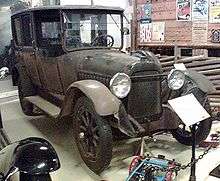 1918 limousine |
 1922 open touring car |
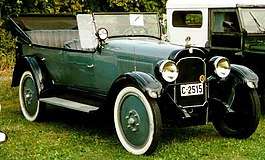 1922 open touring car |
See also
- List of defunct automobile manufacturers
- Brass era
References
- Zatz, David. "Roots of Chrysler: Chalmers cars". www.allpar.com. Archived from the original on 22 July 2013. Retrieved 19 June 2013.
- "1911 Was a Good Year for Chalmers" (PDF). The Chalmers Automobile Newsletter. 9 (3): 2–4. July 2004. Retrieved 6 February 2020.
- Naldrett, Alan (2016). Lost Car Companies of Detroit. ISBN 9781467118736.
- "How Chalmers (& Maxwell) Became Chrysler" (PDF). The Chalmers Registry. 9 (1): 1–5. Retrieved 2 February 2020.
- "Maxwell Motor Profits". p 13 (41601). The Times. 5 Oct 1917.
- Kimes, Beverly Rae; Clark, Henry A., Jr. (1989). "Chalmers". Standard Catalog of American Cars 1805-1942 (second edition). Krause Publications. p. 257. ISBN 0-87341-111-0.
- Clymer, Floyd (1950). Treasury of Early American Automobiles, 1877–1925. New York: Bonanza Books.
- "CHALMERS MOTORS CUTS PRICES: Reduced for All Kinds With Production Down to About Twenty Cars a Day". The Wall Street Journal. Nov 2, 1921. ProQuest 130007977.
- "The Chalmers Automobile Newsletter" (PDF). The Chalmers Automobile Registry. Retrieved 27 January 2020.
- "The Chalmers Automobile Newsletter" (PDF). Chalmers Registry. Retrieved 22 January 2020.
- Hammond, D. C. "The Chalmers Automobile Newsletter" (PDF). The Chalmers Automobile Registry. Retrieved 25 January 2020.
- "The Chalmers Automobile Newsletter" (PDF). The Chalmers Automobile Newsletter. Retrieved 1 February 2020.
- "The Chalmers Automobile Newsletter" (PDF). The Chalmers Automobile Newsletter.
- "Chalmers Automobile Registry" (PDF). Retrieved 25 January 2020.